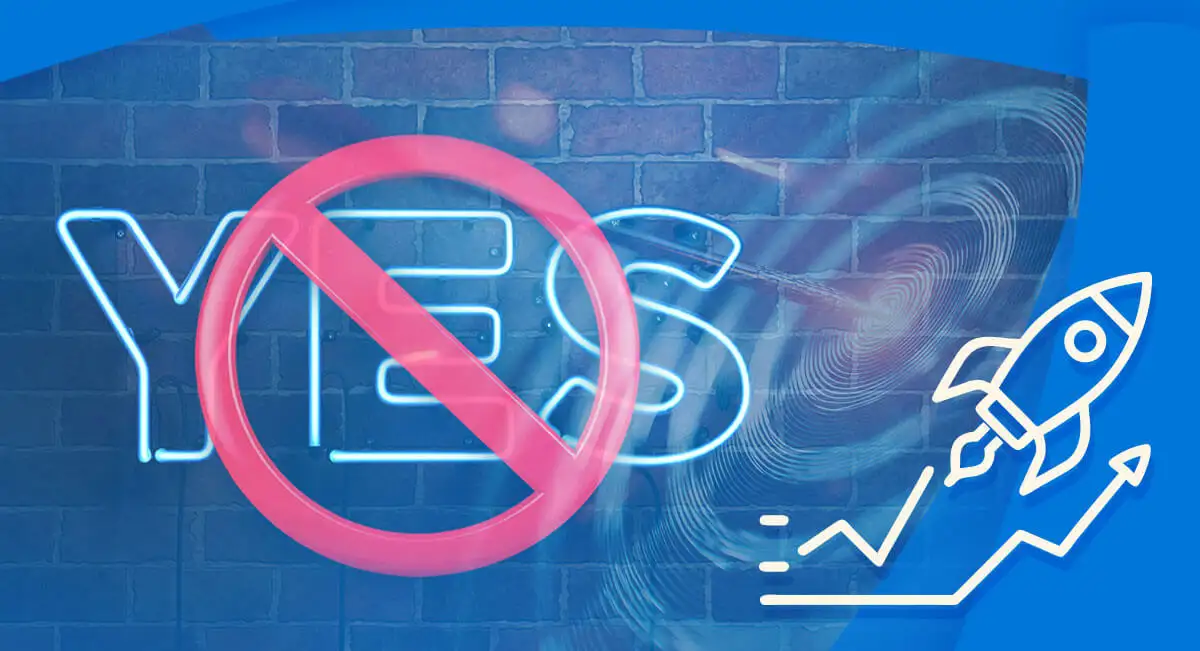“If you’re everything to everyone, you’re nothing to the market.”
What if your biggest growth problem isn’t too few clients, but saying yes to the wrong ones? Eight figures come from saying no to 90% of leads and owning 1% of one market.
Last week, we sat down with Corey Quinn, former CMO of Scorpion. He has helped scale Scorpion from 20 million to 200 million by going deep in a few verticals.
In this guide on agency specialization, Corey shows you how to choose a profitable niche, build repeatable systems, raise prices with confidence, and reveal the $10M agency shortcut no one talks about.
Acquire and serve 10x more clients with AI-powered software
The Generalist Trap: Why Agencies Burn Out
The Generalist Trap is Corey Quinn’s signature concept describing the self-reinforcing negative cycle that keeps most agencies stuck, burnt out, and unable to scale past six figures.
It starts with the classic iceberg problem. What you see above the surface, low-quality leads, weak close rates, churn, and messy delivery, is just the symptom. What’s underneath is far more dangerous: a lack of strategic focus and identity.
Here’s what a generalist trap looks like:
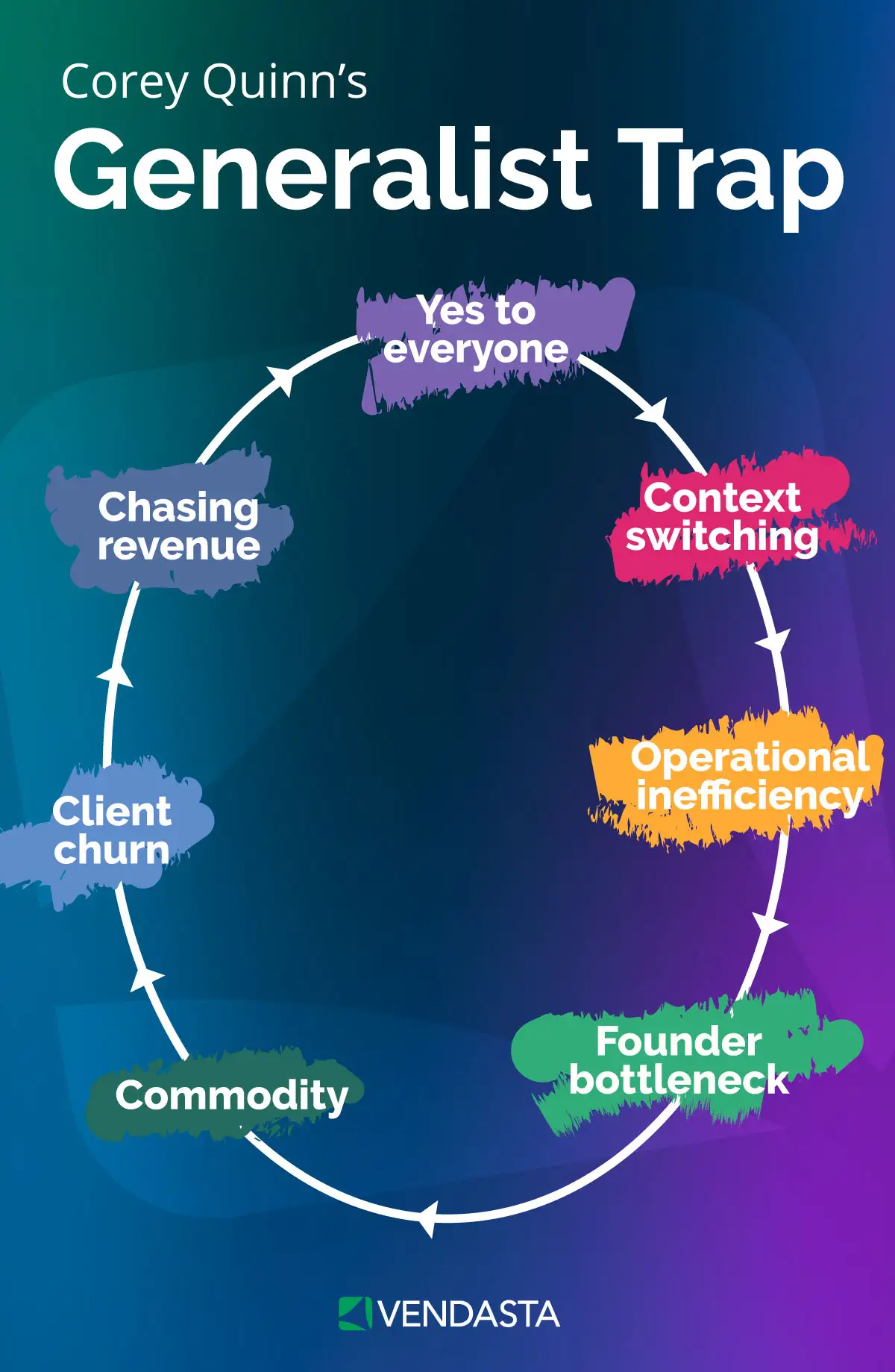
Saying Yes to Everyone
Most agencies welcome every business that walks in the door, driven by the fear of an empty pipeline. The local lawyer. The fitness coach. That friend-of-a-friend with a cool app idea.
Taking on any client feels like survival mode, yet every time you sign on a non-ICP client, your team ends up paying the price. Most agencies don’t have a clear answer to two critical questions:
- Who do you serve better than anyone else?
- What problem do you solve exceptionally well for them?
Because they haven’t answered these, they end up saying yes to any client that’s “close enough,” until every new client feels like a custom project.
Without agency specialization, every new client feels like a custom project.
Context Switching Kills Scale
Imagine working on a dental practice website on Monday, a personal injury SEO strategy on Tuesday, and an ecommerce build on Wednesday. Your team is forced to relearn a new business model, new customer expectations, and new competitive landscapes every single week. On the surface, it looks like you are scaling, but you’re really just scaling chaos.
Operational Inefficiencies (The SOP Graveyard)
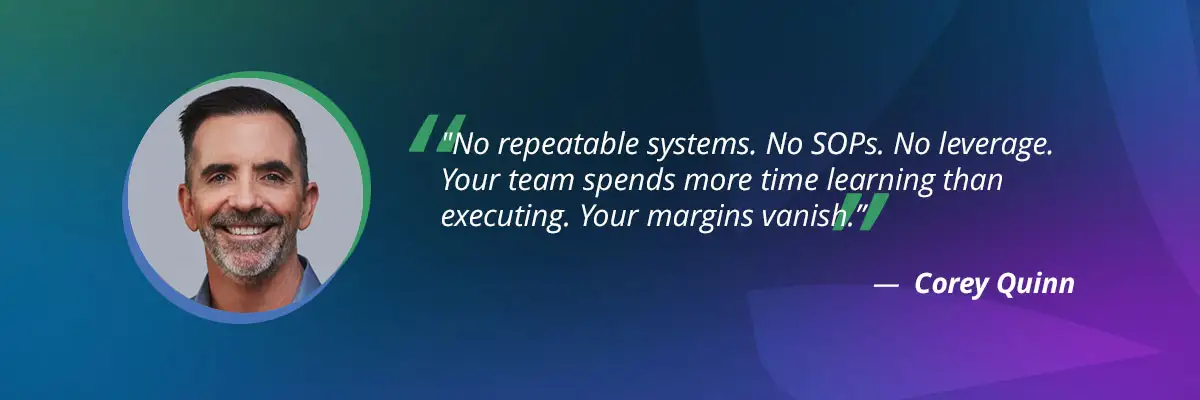
You may have written SOPs, but they collect dust on a shelf or sit in people’s heads. Juggling between industries and niches makes standardization feel almost impossible, and as a result, quality takes a back seat.
Founder Bottleneck
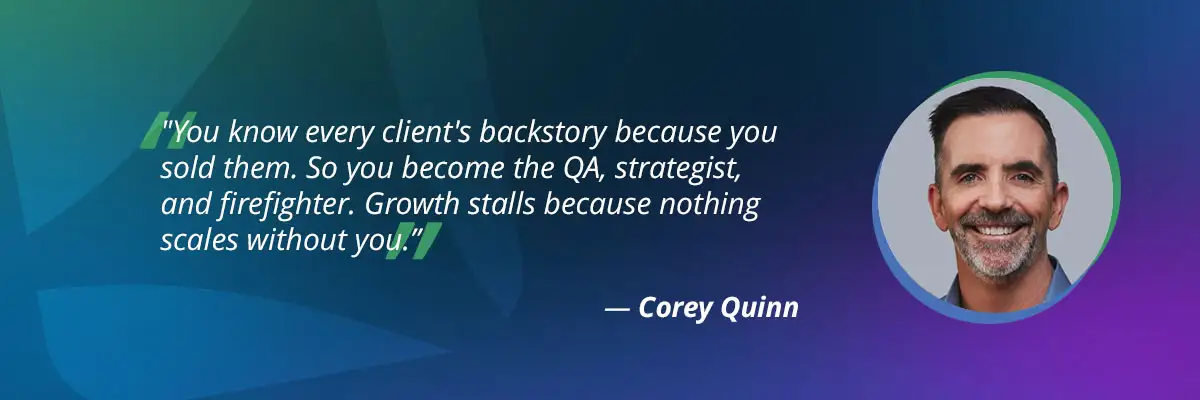
The biggest bottleneck is right at the top: the founder. Only they know what was sold, to whom, and the promises made. When a business depends too heavily on its founder, scope creep becomes inevitable because there are only so many hours in a day to make sure everything runs as it should.
Clients See You as a Commodity
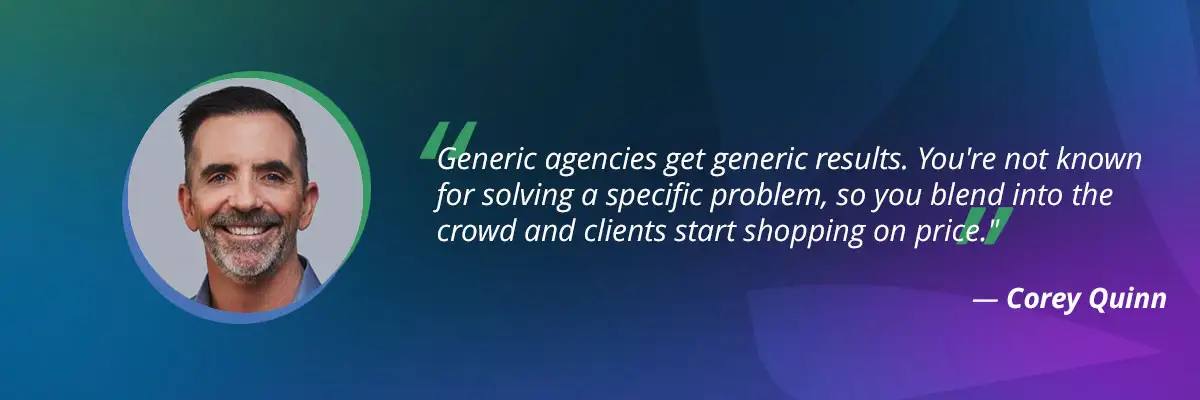
When your message is generic, clients don’t see expertise; they see a commodity. Without vertical authority or proprietary insight, you end up selling activities off a menu, responding to RFPs driven by price, and competing in “good, better, best” comparisons run by procurement. That dynamic pulls everything down, stretching sales cycles, compressing margins, and pushing discounts higher.
Churn Triggers Revenue Panic
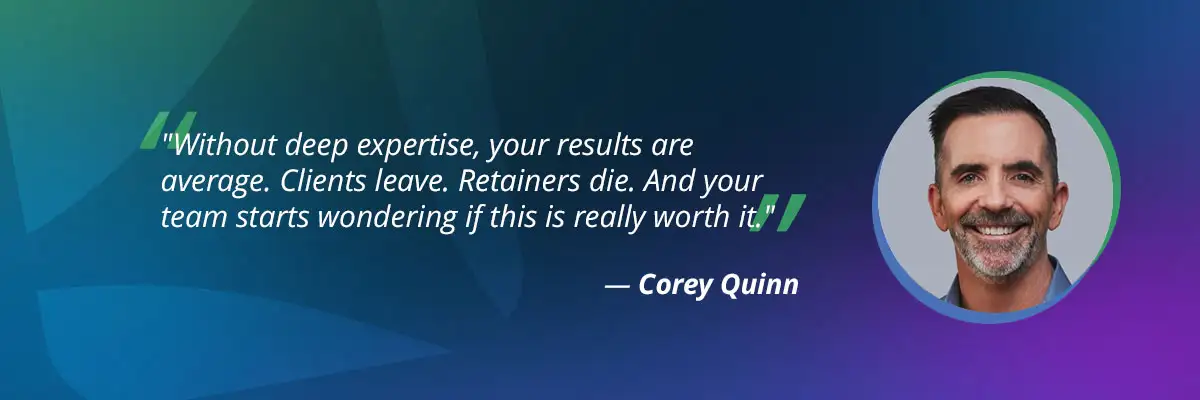
Clients leave sooner and more often because expectations are poorly set, results are inconsistent, and specialists appear more credible. Customer acquisition cost (CAC) takes longer to recover, if at all, while lifetime value (LTV) and your LTV-to-CAC ratio collapse. That gap blows a hole in your forecast and triggers the urge to backfill at any cost, which only invites more bad-fit deals and keeps the spiral going.
As a result: you say yes to everyone (again)!
And that’s the generalist trap. A hamster wheel disguised as hustle.
The Three Filters for Picking a Profitable and Sustainable Niche Vertical
Agencies that embrace agency specialization grow faster and keep more margin. It’s about finding a market you want to serve so well that your competitors don’t stand a chance.
Promethean’s latest State of Digital Services shows specialists outpacing generalists on both revenue and profitability. In 2024, the market grew only 4.5% on average, yet focused firms still grew two to three times faster than the field.
But pick the wrong niche and you pay twice. Before picking a niche, run it through Corey’s three filters to stack the odds in your favor:
1. Harvest the Wisdom You Already Have
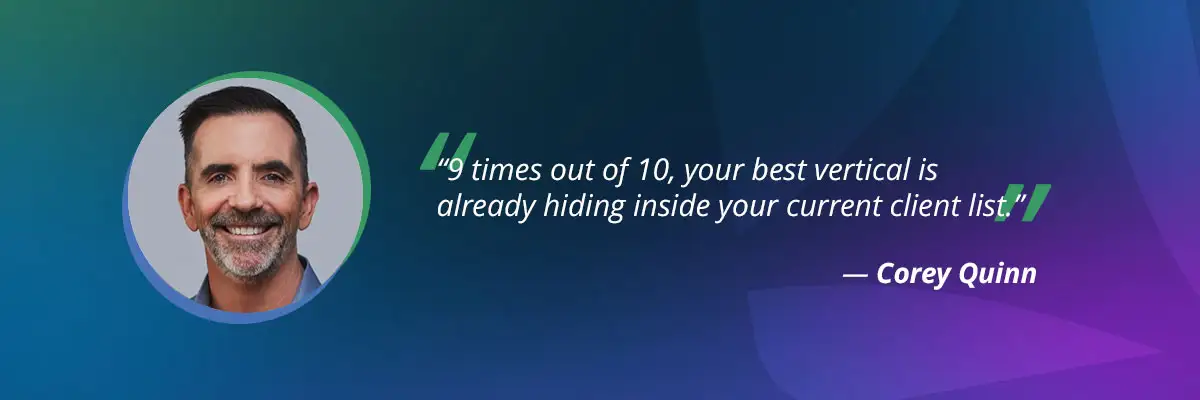
Start by auditing your current book of business, group clients by vertical, and run a simple quant review.
- Average revenue per client, lifetime value, gross margin.
- Retention and referral velocity.
- Win rate and sales cycle length.
- Inbound volume by vertical and sources.
In addition, talk to the customer-facing teams within your business. Who does the sales department love doing business with? Which clients are the easiest to serve? Where do your playbooks run as written? What audience do you already understand better than 95% of your competitors, and how long will you keep ignoring that unfair advantage?
2. You Have to Give a Damn
Ask yourself two simple questions.
- Which market do you actually give a damn about?
- And how would your strategy shift if you built a category-leading agency to serve those people?
Sustainable specialization requires emotional investment; you must be intrinsically motivated and willing to immerse yourself in the vertical’s nuances. You will be on their stages, in their groups, and writing in their language. If you do not care about the people and their mission, you will not outlast competitors who do.
This means choosing a vertical that aligns with your agency’s values, interests, or mission, and ensuring that leadership and staff feel passionate and empathetic towards the clients’ challenges.
3. Size the Addressable Market, Then Run the Three-Year Math
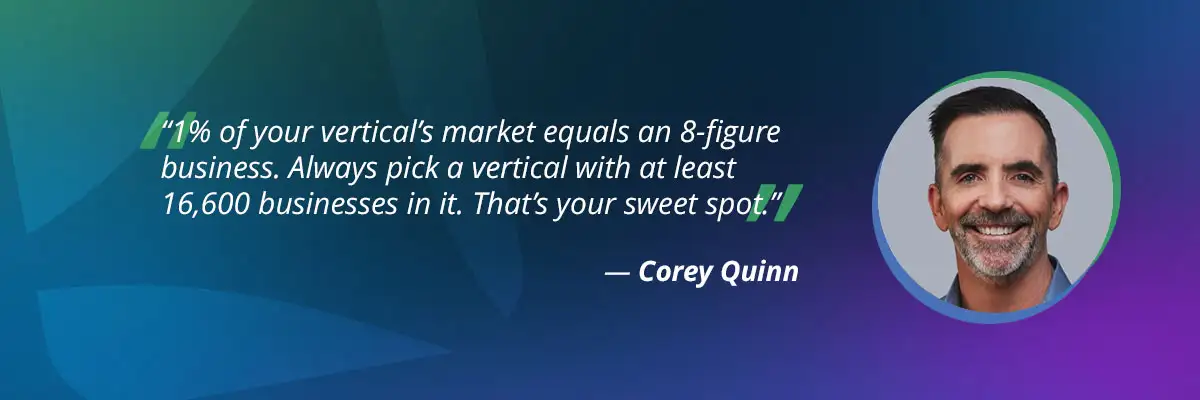
Your market size should justify building a business in that niche. For example, if your target vertical has at least 16,600 businesses, and you win just 1% of them (about 167 clients) at an average of $5,000 per month, you are running an eight-figure agency within a year.
If you are unsure about a niche, here’s a quick way to test its potential:
Start with the total number of businesses in that niche and multiply it by 20% to identify your “sweet spot.” This represents the portion of the market that is realistically within reach based on geography, pricing, or service fit. Then multiply that number by 3% to estimate the clients you could reasonably acquire within the first one to two years. Finally, multiply that client count by your expected average monthly or annual revenue per client.
The result should excite you. If it does not, pick a different vertical.
What if you are too early to verticalize?
If you do not yet have a client base that fits the math above, do not force a niche too soon. Focus on winning 10 to 20 projects, measure retention and profitability, and then revisit your shortlist using this framework.
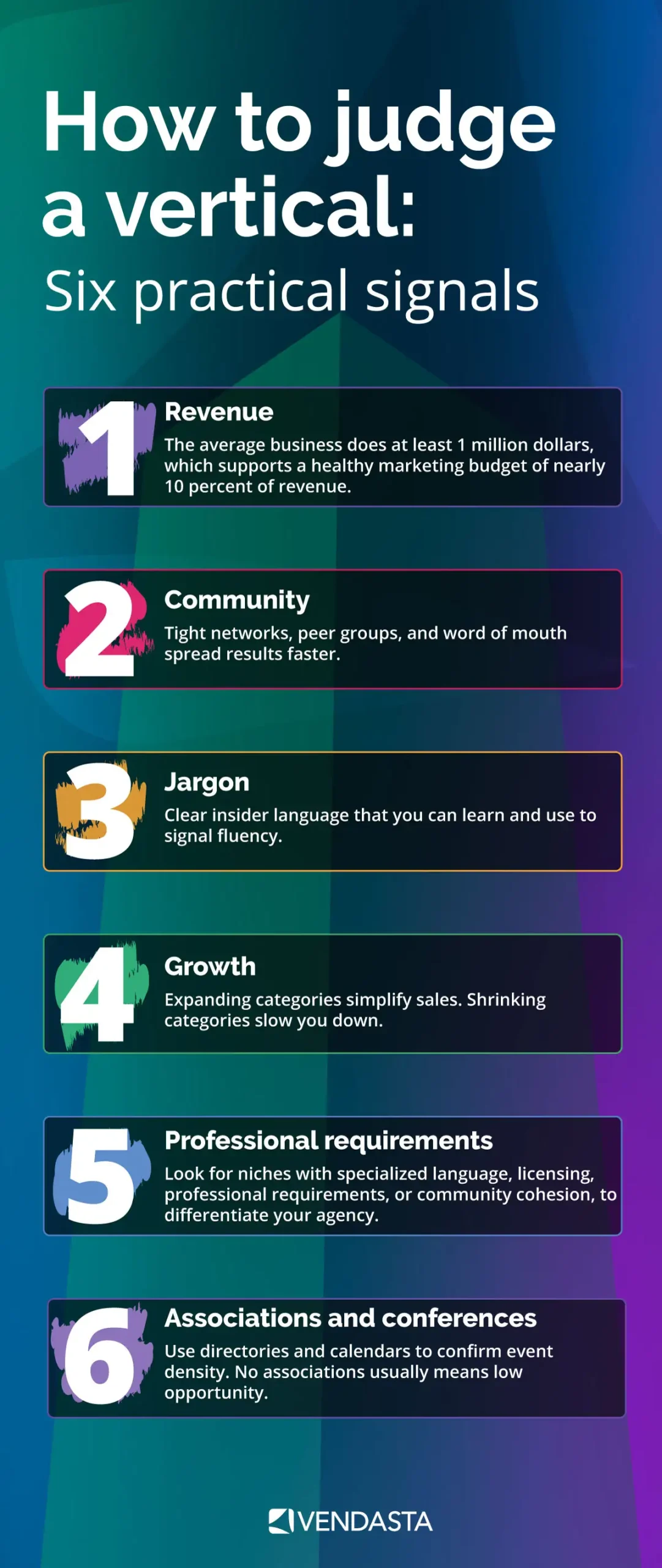
From Chaos to Compounding: The Deep Agency Specialization Flywheel
You’re on the brink of trading chaotic, one-off projects for a smooth, accelerating growth engine. This is what Corey calls the Deep Specialization Flywheel. A deep focus on a single vertical compounds your business advantages, turning isolated wins into predictable, scalable momentum.
Here’s a synthesis of Corey’s key insights about how this flywheel works:
1. Pick One Vertical and Commit
Choose one market where you already have proof and energy. Your goal is to become the trusted choice for a single painful problem. Constant, focused work within one vertical lets your team learn faster and build deep expertise, reducing friction and increasing confidence.
Once you have decided to niche down, let your chosen vertical/verticals bask in the limelight on your homepage and in your offers. Make sure your entire brand strategy shouts one promise, one onboarding, one set of KPIs. Make sure all content, events, and outreach speak to one buyer persona.
2. Concentrated Expertise
Repetition enables operational leverage. Solve the same problem again and again. Teach your team your industry’s language, KPIs, seasonality, and buying cycles. Build a problem bank, and start by listing the top 20 pain points for your vertical, with symptoms, causes, and fixes.
Standardize inputs, brand assets, credentials, top five competitors, past media, CRM access, and tracking plan. After working with 5 to 10 similar clients, your team should ideally stop relearning the basics and shift their focus from “what should we do” to “which pattern fits.”
3. Systems and Software
Build an assembly line for onboarding, delivery, and reporting.
Start by collecting access using a clear checklist, align on a tracking plan, complete a creative brief, ship a baseline report, and lock a go-live calendar, all within 7 days. Document three winning plays tied to context, for example, single-location, multi-location, and high-urgency offers. and lock the steps, SLAs, and QA for each path.
Run a consistent stack, analytics, call tracking, CRM, ad platforms, landing pages, and reviews, and use prebuilt templates so the team saves hours on every build. Finally, run a preflight checklist before launch, mid-flight checks on day 7 and day 21, and a 45-day optimization review to catch issues early and compound wins.
4. Results on Demand
When your inputs and plays are consistent, your outcomes become predictable, and case studies line up apples to apples. Corey advises choosing three lighthouse metrics, such as cost per qualified consult, show rate, and revenue per location, and publishing baselines and targets.
Once you have your metrics in order, run A/Bs with rules, one change at a time, a clear win condition, and a seven to fourteen-day window. Not only should you benchmark the report, but you should also aggregate anonymized results each quarter and share them with prospects and clients.
For instance, you can say, we lift qualified intakes by 35% in the first 90 days on average for firms between 2 and 10 attorneys, because now, your data backs up your claim.
5. Premium Pricing and Margin
Efficiency combined with rare expertise earns higher retainers and longer retention. This is when you can price for outcomes, not tasks. Corey advises ditching the good-better-best menu format and tie price to client economics, such as signed cases, chair time, and average ticket.
Corey has developed a specific sales framework called the Six-Slide Trust Multiplier designed for specialized agencies to build trust within the first 10 minutes of a sales call. Instead of falling into transactional pricing traps or generic menus, this proven approach helps them demonstrate their vertical expertise immediately and use consultative selling to uncover deep client needs rather than selling pre-packaged tiers.
This framework accelerates trust, shortens sales cycles, and boosts close rates, helping agencies maintain premium pricing and attract the right clients. This approach allows them to differentiate from generalists stuck with “good, better, best” pricing.
At Scorpion, Personal injury firms paid $10,000 to $30,000 per month and stayed about 30 months. Generalists sold $2,000 bundles and lost clients in 12 months. The LTV gap, about $300,000 versus $24,000, funded better sales, marketing, and product, helping them maintain dominance while competitors struggled to keep pace.
6. Reinvest into the niche
Higher margins let you reinvest back into your vertical niche. Invest in staff training, improving domain expertise further, scale sales and marketing programs designed for that vertical, and develop proprietary tools or technology that strengthen client outcomes.
Scorpion invested $100K+ in a Tesla giveaway at the IFA conference and generated 100+ franchise clients from this single vertical-focused initiative. This shows how high-investment, vertical-specific marketing creates breakthrough results.
AI and Agency Specialization: Your Unfair Competitive Advantage
The convergence of vertical specialization and artificial intelligence creates a compounding advantage that generalist agencies cannot replicate. While AI tools are widely available, specialized agencies extract exponentially more value because they deploy AI with precision, context, and industry-specific intelligence.
This is because vertical agencies possess what generalists lack: deep, industry-specific context. General-purpose AI struggles when it lacks domain expertise. Generic prompts produce generic outputs. But when you feed AI systems with rich, vertical-specific knowledge, buyer psychology, industry jargon, regulatory frameworks, competitive landscapes, and proven messaging patterns, the quality of outputs transforms dramatically.
As Corey explains, “One of the best ways agencies can use AI when it comes to trying to find scale is when they are specialized. They have the benefit of having a very specific context window.”
Think of it this way:
A generalist agency might prompt AI to “write a blog post about increasing leads.”
A specialized agency serving personal injury law firms prompts AI with precise context: “Write a 1,200-word blog post targeting personal injury attorneys in mid-sized markets explaining how to increase qualified case intakes from motor vehicle accidents using Google Local Services Ads, including compliance considerations for attorney advertising rules and benchmarks showing a 35 percent lift in qualified consults within 90 days.”
The difference in output quality is night and day.
AI as Operational Leverage
Here’s how vertical agencies are deploying AI across their operations:
Content Creation at Scale
Specialized agencies train AI with their vertical’s language, pain points, case studies, and proven messaging frameworks. This enables them to produce blogs, social posts, ad copy, email sequences, and landing pages that sound authentic and resonate with their target buyers at 10x the speed of manual creation.
Campaign Optimization
AI analyzes campaign performance data across dozens of similar clients in the same vertical, identifying patterns generalists miss. Specialized agencies feed AI historical data about what works for personal injury lawyers, franchise owners, or dental practices, then use predictive models to optimize bids, creative, and targeting faster.
Automated Reporting and Insights
Instead of manually compiling reports, specialized agencies use AI to aggregate anonymized performance data across their client base, benchmark results, and generate customized client reports complete with industry-specific KPIs and recommendations.
Sales Process Automation
AI-powered tools draft personalized outreach sequences, qualify inbound leads based on vertical fit, and even generate customized sales decks tailored to prospect pain points—all informed by deep vertical knowledge.
Operational Workflows
From client onboarding checklists to QA processes, specialized agencies use AI to document, automate, and improve repeatable systems. AI helps standardize what was once custom, reducing errors and speeding execution.
Why Generalists Cannot Compete
Generalist agencies face a fatal limitation: they lack the concentrated data, insights, and context to make AI truly effective.
Without vertical focus, generalist agencies cannot:
- Train AI with industry-specific buyer personas, objections, and decision criteria
- Feed AI benchmarks, case studies, and proven playbooks from dozens of similar clients
- Use AI to predict outcomes based on vertical-specific patterns
- Automate workflows because every client engagement is different
As a result, generalists produce mediocre AI outputs that require heavy human editing. Specialized agencies produce near-final outputs that require light refinement. The efficiency gap compounds over time.
The Future Belongs to Vertical AI Agencies
Industry analysts predict that vertical AI will grow from 5.1 billion dollars in 2024 to 47.1 billion dollars by 2030. This explosive growth reflects a fundamental shift: businesses demand AI solutions that understand their specific challenges, not generic tools that require constant customization.
As AI adoption accelerates, agencies with deep specialization will pull further ahead because AI makes their expertise more scalable, not less valuable. The combination of human domain expertise and AI-powered automation creates a flywheel effect: better insights lead to better outputs, which create better results, which attract more clients, which generate more data, which improve AI performance even further.
Agency Specialization Made Scalable with Vendasta
Most agencies understand that agency specialization is the key to predictable growth, but executing it consistently across marketing, sales, fulfillment, and reporting is the real challenge.
That’s where Vendasta helps specialized agencies turn focus into scale.
Turn Your Niche Expertise into Repeatable Systems
Vendasta’s all-in-one platform lets agencies standardize workflows around their chosen vertical. Whether you serve home services, legal, or healthcare clients, you can build repeatable playbooks for prospecting, onboarding, fulfillment, and client reporting, all from one centralized hub.
Automated onboarding checklists, templated campaigns, and pre-built performance dashboards ensure that every client engagement follows the same proven process. Your team can deliver consistent results without reinventing the wheel each time.
Automate Client Reporting and Prove Your Vertical Expertise
Agencies that specialize win on results. With Vendasta’s Executive Report, you can automatically compile metrics that matter to your vertical, from ad performance to reputation growth, and showcase ROI in a way that builds trust and retention.
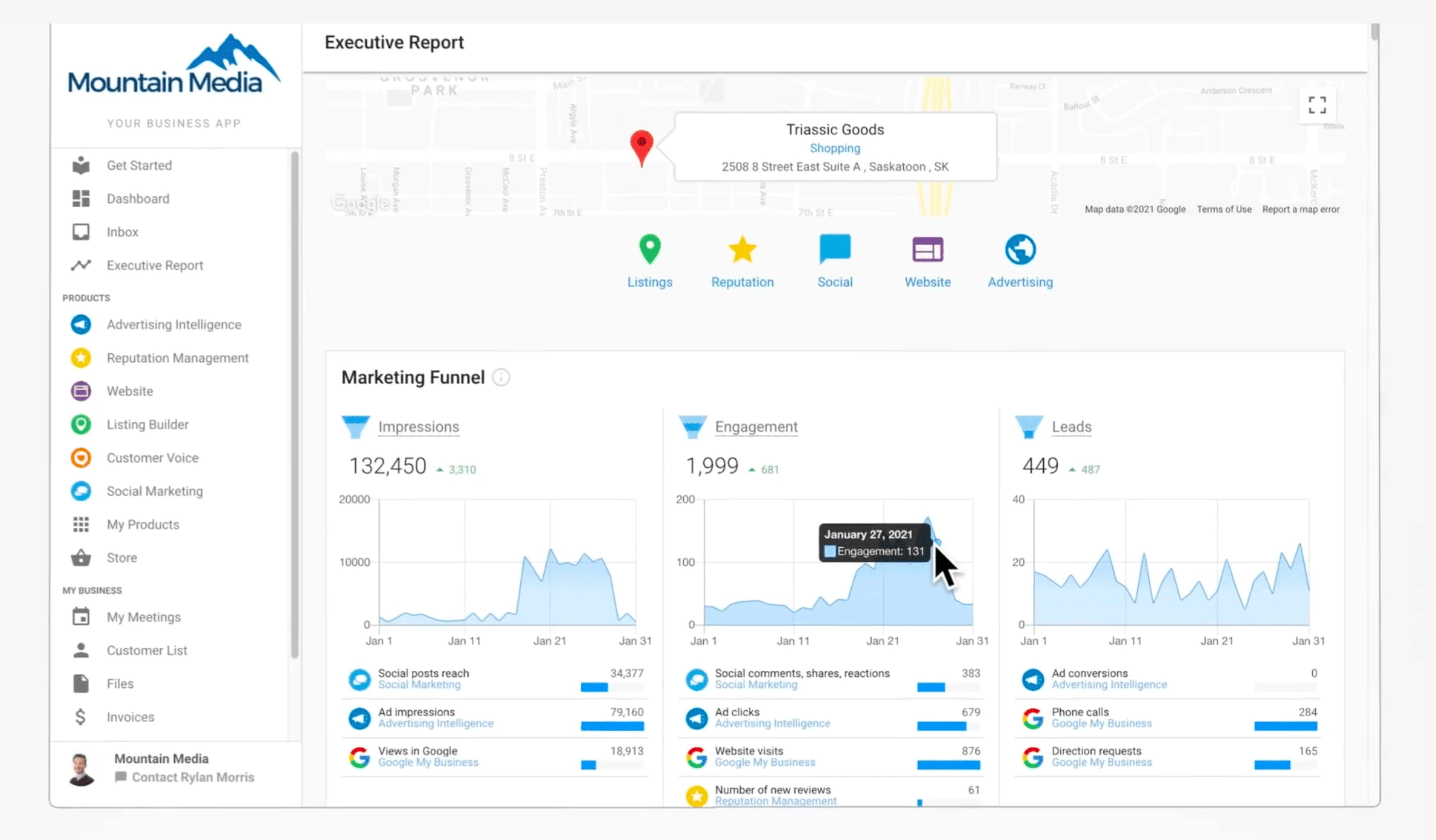
No more time-consuming manual reports. Vendasta’s AI automates data collection and visualization, giving you branded reports that highlight your niche expertise and measurable impact.
Use AI as Your Growth Multiplier
Vendasta’s AI Employees give specialized agencies a competitive edge by automating repetitive tasks, improving client engagement, and amplifying lead generation. Combined with your deep industry knowledge, these AI employees help you grow smarter, not harder.
For example, your AI Receptionist ensures you never miss an opportunity by being available 24/7 to capture leads, answer questions, and provide instant, personalized responses across phone, SMS, and chat. It filters out spam, records every conversation in your CRM, and delivers a seamless experience that builds trust and keeps customers coming back.
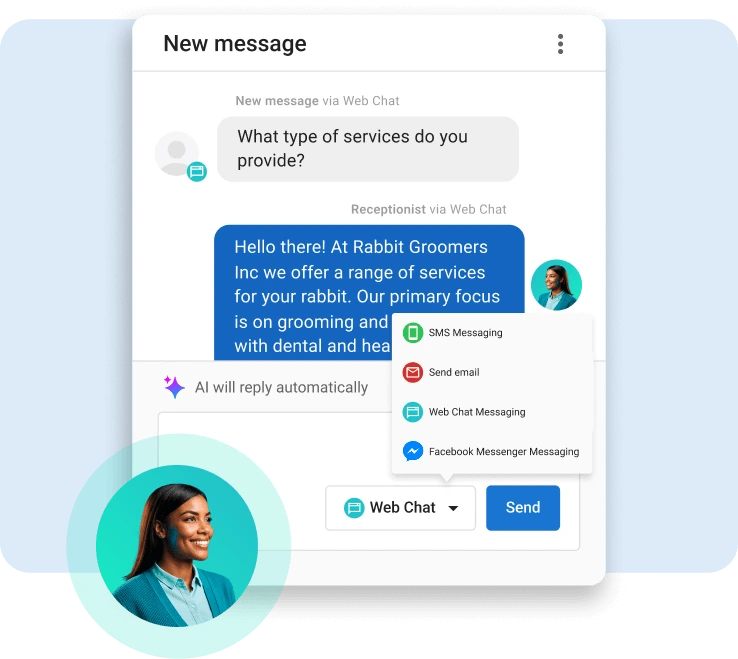
Scale Your Niche with White-Label Power
Once your vertical playbooks are proven, Vendasta makes it easy to expand and resell them under your own brand. The platform’s white-label Marketplace lets you bundle services, launch recurring revenue products, and grow your specialized agency without needing to build new infrastructure or tools from scratch.
Agency Specialization FAQs
1. What does deep agency specialization actually mean?
Deep agency specialization isn’t just about niching down. It’s a strategic and methodical process designed to transform an agency from founder-led to business-led. It helps agencies stop competing on price and become the go-to expert in a vertical market. It’s about turning your agency from a generalist to a revenue-predictable business that owns its category, not just serves it.
2. Why do generalist agencies struggle to scale?
This is the “generalist trap” that Corey frequently refers to. When agencies say yes to everyone, they destroy efficiency and commoditize their work. When you’re building a site for a dentist one day and running PPC for a SaaS company the next, your message and value dissolve. Generalist agencies sound like everyone, and commodities get replaced. The cure is focus: pick a vertical and dominate it.
3. What are the four levels in the Deep Specialization Maturity Model?
According to Corey Quinn, there are four maturity levels agencies move through as they specialize:
- Generalist Agency: Saying yes to everyone; unpredictable revenue.
- Vertical Vendor: Beginning to target one vertical.
- Vertical specialist: Known as an expert in that industry.
- Vertical Maven: A fully trusted leader who defines the standard in the market.
The goal isn’t just to specialize. It’s to reach the Maven level, where your agency defines credibility and commands loyalty in your vertical.” The framework is designed to take agencies from “fighting for scraps” to being the brand prospects already trust before your first call.
4. How does deep agency specialization increase profitability?
Deep agency specialization creates a flywheel of operational and market advantage. Agencies that specialize can charge premium pricing and retain clients longer.
At Scorpion, specializing in personal injury law meant clients stayed for 30 months at $10K–$15K per month. Competitors, selling general packages, churned after 12 months on $2K retainers. That’s a $300,000 vs. $24,000 client lifetime value difference. That margin allowed Scorpion to reinvest in better marketing, staff, and client experience, creating a self-reinforcing growth cycle.
5. How should agencies choose their vertical market?
There are 3 steps to choosing a Vertical Market:
- Tap into your expertise: choose industries you understand deeply.
- Follow your genuine interest: avoid markets you’ll grow tired of.
- Analyze market potential: verify the vertical’s revenue opportunity and demand trends.
Corey Quinn also warns against selecting markets that are too small or irrelevant to long-term agency goals.
6. How does reinvestment play a role in sustaining specialization?
Corey emphasizes reinvesting excess margin into your vertical, such as funding better tools, training, and content to deepen expertise. He calls it the “vertical moat.” This is what keeps competitors out once your flywheel begins spinning. It’s the evolution from being a vertical participant to being its leader.
7. What measurable business outcomes come from this framework?
Corey’s data-backed insights show that agencies applying Deep Specialization typically experience:
- Higher client retention (2–3x longer cycles) due to trust and category expertise.
- Higher margins (40–60% more profitable) through premium pricing.
- Predictable revenue growth, as buyer trust compounds over time through authority positioning.
8. How does Vendasta help agencies standardize their niche operations?
Vendasta’s all-in-one platform lets specialized agencies create repeatable systems for their chosen vertical. Agencies can automate onboarding, fulfillment, and reporting with prebuilt workflows and templates, allowing them to scale their expertise consistently and profitably.
9. Can Vendasta’s AI tools enhance agency specialization?
Yes. Vendasta’s AI Employees empower specialized agencies to automate repetitive tasks, capture and qualify leads, and improve client engagement. With vertical context, AI tools deliver smarter insights and personalized communication that amplify the impact of your niche expertise.
10. Why should specialized agencies choose Vendasta to scale?
Vendasta helps agencies turn vertical success into scalable systems. With its white-label products and automated reporting tools, agencies can resell proven solutions under their brand, expand into new markets efficiently, and showcase measurable ROI for every client.


